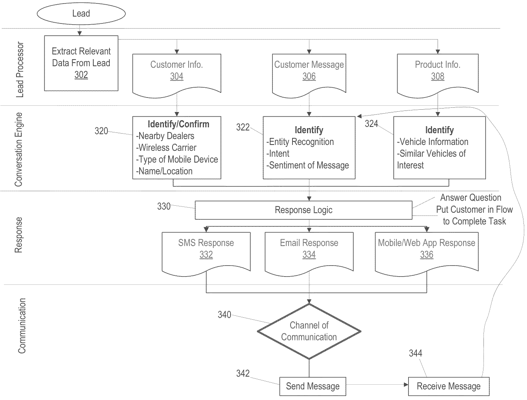| US 11,777,874 B1 | ||
| Artificial intelligence conversation engine | ||
| Mikhail Semeniuk, El Cerrito, CA (US); Hollin Wilkins, Freeville, NY (US); Thomas Taira, Lafayette, CA (US); and Bernard Brenner, Austin, TX (US) | ||
| Assigned to Carvana, LLC, Tempe, AZ (US) | ||
| Filed by Carvana, LLC, Tempe, AZ (US) | ||
| Filed on Dec. 12, 2019, as Appl. No. 16/711,902. | ||
| Claims priority of provisional application 62/779,737, filed on Dec. 14, 2018. | ||
| Int. Cl. G06F 40/30 (2020.01); G06F 40/295 (2020.01); H04L 51/02 (2022.01); G06N 20/00 (2019.01); G06N 5/04 (2023.01); H04L 51/216 (2022.01); H04W 4/14 (2009.01) | ||
| CPC H04L 51/02 (2013.01) [G06F 40/30 (2020.01); G06F 40/295 (2020.01); G06N 5/04 (2013.01); G06N 20/00 (2019.01); H04L 51/216 (2022.05); H04W 4/14 (2013.01)] | 12 Claims |

|
1. A method for automated conversations with users by an artificial intelligence (AI) conversation system, the method comprising:
receiving an N number of messages from a customer in a conversation, where N is a value greater than 1 and each of the N number of messages includes message text; for each of the N number of messages:
applying to the received message text a topic category model that has been trained to compare a text feature vector of the message text and a set of topic category reference feature vectors determining a highest similarity topic category reference feature vector to the text feature vector;
determining a topic category represented by the highest similarity topic category reference feature vector;
applying to the received message text an intent model that has been trained to compare the text feature vector of the message text and a set of intent class reference feature vectors determining a highest similarity intent class reference feature vector to the text feature vector;
determining an intent class represented by the highest similarity intent class reference feature vector;
determining a requested intent for the message based at least in part on the message text using one or more machine learning models; and
storing the requested intent in a dataset associated with the customer;
receiving a new message from the customer in the conversation after receiving the N number of messages, the new message including received message text; extracting, from the received message text, one or more entities included in the received message text; determining a state of the conversation based at least in part on the new message; predicting information based on the extracted one or more entities and the 1 to N requested intents stored in the dataset for use in a response to the received message text; and constructing the response to the received message text based on the extracted one or more entities, the determined state of the conversation, the topic category, the intent class, and the predicted information. |